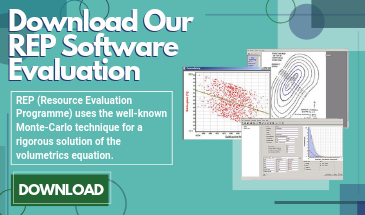Blog
Burst echoes – too full of themselves?

Burst echoes – too full of themselves?
Early NMR wireline logs were challenging to interpret, not least because the tools themselves were somewhat primitive compared to their modern equivalents.
The first MRIL’s produced a stream of decaying echoes spaced 1.2 milliseconds (ms) apart. So if you were trying to measure something decaying pretty fast it was a challenge.
You can see how much of a challenge by using the exponential decay equation A = Ao . Exp(-t/T2), where A is the amplitude at time t, for a component with initial amplitude Ao and decay time T2
Here’s a table showing remaining amplitude in a measurement at echo spacing 1.2ms, for three components of 2ms (typical of clay bound water), 20 ms (typical of capillary bound water) and 200 ms (typical of free fluid).

You will probably be OK with the T2=200ms material, it hardly decays at all in the first 20 echoes. But the clay bound is essentially gone in 5 echoes, and the capillary bound is at half the initial after just 11 echoes. Now add in the fact that this is a very noisy measurement and you quickly realise that measuring any fast component is a dodgy proposition, and the clay components almost impossible with any accuracy.
What to do?
One problem with NMR logging (which still remains, by the way) is that it’s very slow, and therefore -as any driller will tell you – expensive. You have to wait around while the permanent magnet in the tool polarises the measurement volume. How long this “wait time” (TW) needs to be depends on what has to be polarised but should normally be at least 4 seconds and in a gas reservoir 10 or more seconds. Numar, who developed the MRIL tool, realised that if they did a whole lot of short measurements at very short TW (say 20 measurements at TW=0.02ms) they would not significantly increase the overall measurement time – and therefore the logging speed – and would get some valuable extra data. And not only that, if you stacked (averaged) the 20 short TW measurements (the famous burst echoes) you would significantly increase the signal-to-noise ratio – in fact by a factor of the square root of 20 or over 4. The argument went: yes the polarisation time (T1) is very short but because T1 is closely related to decay time T2 those components which we do polarise and therefore measure with the burst echoes are the fast decaying ones – exactly the ones we are having trouble measuring in T2.
In general as the echo spacing gets shorter so the echo train gets noisier, but because they were taking 20 or 30 burst echoes trains and stacking them the noise was effectively reduced, and there was scope therefore to decrease the echo spacing. Burst echoes in MRIL tools are taken at 0.6ms, which approximately doubles the number of echoes you can use to measure any component. (Approximately, because as you increase the echo spacing so the diffusion element of the T2 decay increases.)
Doubles all round, in fact!!
Schlumberger’s first CMR tool had an echo spacing of 0.28ms. In terms of the possible resolution of fast components it was a big improvement – even if the echo train was rather noisy and prone to spikes. The CMRplus followed with TE=0.2. You can see from the table that the fast component doesn’t get down to 5% of initial until echo 30. On top of that the CMRplus also has burst echoes – 30 measurements also at 0.2ms.
Now the question is: how do you integrate the main and burst echoes to arrive at a T2 spectrum which uses the burst to resolve the fast components and the long TW train (“main”) to resolve the long T2 components?
The main problem is that the two measurements – main and burst – are measuring different things. In the main measurement everything is fully polarised (fingers crossed anyway). In the burst only very fast components are fully polarised. Everything else is partially polarised, and the longer the T2 the less it’s polarised.
You can see the problem in this plot:

On the left plot is a typical bimodal T2 distribution. Only the short time peak on the left of the distribution polarises the burst echoes. On the right you see the two echo trains: the short burst with miles less amplitude than the long main.
In the old days people would splice the burst T2 with the main T2, which would work in this case (more or less) but would be a muddle if there was no clear splice point. Or people would “boost” the amplitude of the burst echoes to overlie the main at early time – but again it was a mess if there was no clear separation between components (and even then…)
In fact there’s a perfectly decent equation which infallibly corrects the burst echoes for the lack of polarisation. There are 2 problems:
- You need the T1/T2 ratio for the component in question. This is reliably 1.5 for water. The trouble is that in the oil industry we don’t drill for water, we want oil (not far off 1.5) or gas (depends of pressure and temperature but is 4 or more, very often). So assuming 1.5 – which everyone does – might give you the wrong answer in gas wells, if the burst actually see any gas. There’s a similar concern in unconventional reservoirs.
- The correction depends on T2 – the higher the T2 the bigger the correction. So the danger is that a small signal at mid to long T2 (perhaps real or more likely because of a noisy echo train and a suspect inversion) will get horribly magnified by the correction.
Here’s an inversion of some burst echoes:

That T2 peak at 3000ms at the right of the left hand plot is completely artificial – in the right plot you can see that the short echo train hasn’t decayed. If you correct the T2 for polarisation an apparent 15% porosity jumps to 150%! Combining this with the main train removes the drama but still leaves a question mark over the influence of imperfect measurement.
So should you use burst echoes? Most people think so, and in principle we agree; but in our view you should be a bit careful.
- Is the assumed T1/T2 ratio valid for the fluids seen by the burst echoes? If not, you are making things worse.
- Is the quality of the burst echoes good enough to be reliable?
- If the main and burst trains have different echo spacings are you happy that the effect of the different diffusion terms will have no effect?
NMR is fundamentally a 3D affair: everything you measure has characteristic T1, T2 and diffusion, with the last being also a property of the measurement. A T2 distribution is a 1D solution, and affected by your assumptions of T1 and D. When combining echo trains you need to be very clear about those assumptions, and whether they work in your particular reservoir.
Modern multi-frequency tools attempt to help you by allowing at least 2D solutions to the 3D problems, though the technical limitations of the tools themselves do not always permit a good answer. No one has yet devised a combination of logging tool and solution method which does the 3D job reliably.
One of the really strong features of our LogIC software is that it allows you an intuitive, detailed and visually interactive way of properly looking at the data. NMR analysis can be straightforward but often the true value of the log is only revealed when you do this. And you can’t do it if you don’t have the tools.
Image source: Pixabay




